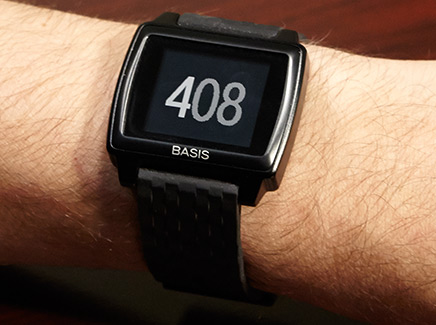Tom's Guide Verdict
The Basis Peak is being recalled due to overheating; do not purchase it.
Pros
- +
Comfortable
- +
attractive design
- +
Tracks sleep
- +
Comprehensive data
- +
Built-in heart rate monitor
Cons
- -
Not all features available at launch
- -
Doesn't track distance
Why you can trust Tom's Guide
As the first wrist activity-band with a built-in heart rate monitor, the Basis B1 helped pave the way for a generation of fitness trackers that provided more information than just the number of steps you take in a day. With the Peak, Basis is adding another wrinkle: smartphone notifications. Taking a page from more-expensive smartwatches, this $199 device will now let you see who's calling or texting, without having to take your phone out of your pocket. But others have caught up to Basis' game; did the company do enough to stay at the head of the pack?
Editor's Note (8/4/16): Basis has issued a recall of every Basis Peak due to reports of the watch causing blisters and burns through overheating. If you own a Basis Peak, please go to the Basis support site to fill out a form for a full refund. Also, as Intel will be shutting down Basis Peak services at the end of 2016, we no longer recommend consumers purchase this device. We have adjusted the rating accordingly.
Design
The Basis Peak's design has evolved considerably from the Basis B1. The bulky, small display of the original has given way to a much slimmer device with a much larger screen. Also, the band on the Peak is now designed like that of a traditional watch, which also makes it feel like less of a sport-centric device, and one that's more at home in a variety of situations.
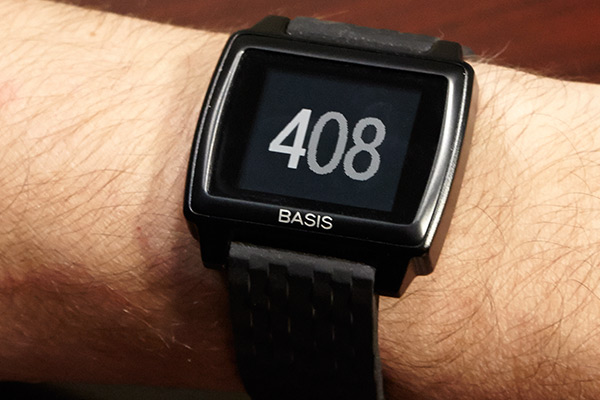
The Peak was a lot more comfortable to wear than the Microsoft Band, whose thicker, hard plastic sides and bottom made it feel much more cumbersome. My Peak review unit came in black with red accents on the underside, but the device is also available in white.
On the underside of the Peak's watchface is an optical heart rate sensor, as well as four metal contacts that measure galvanic skin response — how much you're sweating — and skin temperature. Those measurements, combined with a three-axis accelerometer, help provide a more accurate portrait of the calories you're burning, as well as your overall activity, according to Basis.
MORE: Best Fitness Trackers
Like the upcoming Fitbit Surge, the Peak is water resistant up to 5 atmospheres (165 feet), so you can take it swimming. The Microsoft Band, on the other hand, can only resist splashes.
Display
The 1 x 0.75-inch black-and-white LCD touch screen on the Peak was easy to read in daylight, and its backlight (activated by swiping up along the right bezel) made it easy to see at nighttime, too. While the monochrome readout isn't as bright or colorful as the Samsung Gear Fit or Microsoft Band, it gets the job done.

One great aspect about the Peak is that it always shows the time; the displays on many other fitness bands only turn on a second after you lift them to your face, which saves battery life, but isn't as convenient. Oddly, it only shows the date if you tap on the screen. Why not just show this all the time? The battery life gauge is another thing that should be displayed constantly, but isn't.
Interface
Navigating the Peak's interface is pretty straightforward. As the watch has no physical buttons, you have to move through menus by swiping the device's touch screen. Swipe to the right to show the settings menu, where you can sync the Peak with your phone, see if it's connected, turn on Do Not Disturb and see how much battery life is left.
Swipe to the left, and the heart rate monitor appears. Swipe once more to the left, and you can see stats on your current activity: steps, calories and how long you've been engaged in that particular activity, be it walking, running or cycling. Swiping up from this screen shows your total activity for the day.
And that's about it, for now. Like the Gamin Vivosmart and Microsoft Band, the Peak will show notifications coming from your phone, such as calls, messages and alerts, but this feature won't be enabled until later in 2014.
Habits
Central to Basis' app are Habits, goals that will ultimately lead to a healthier lifestyle. They range from falling asleep at a certain time to burning a certain number of calories to taking a given number of steps per day. Within the app, you can select which Habit(s) you want to strive for. When you choose a Habit, the app tells you why that habit is beneficial.
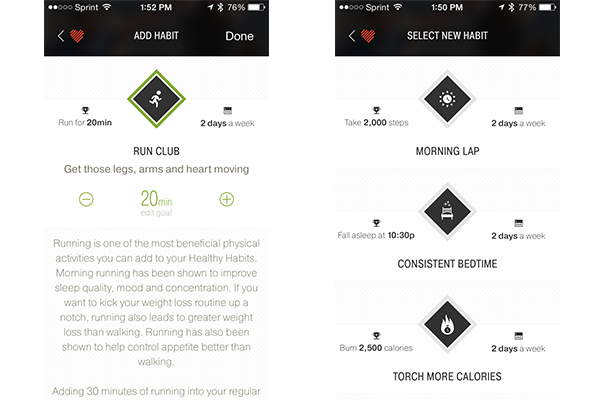
I chose Run Club, which entails running for 20 minutes at least twice a week. According to the app, this helps improve sleep quality, mood and concentration, among other things. You can edit habits, too. So if I wanted to set the goal to run for 30 minutes, I could do so. As you complete each habit, the diamond representing each gets outlined in green.
App
Basis' app continues to be one of the most data-heavy fitness apps out there, which is great for those who like to crunch numbers as much as their abs.
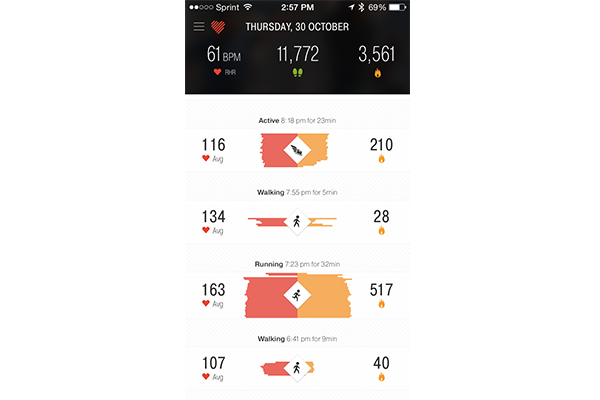
Along the top of the app's home screen, called the Dashboard, is a black bar with metrics showing your resting heart rate, along with steps taken and calories burned during the current day. Beneath that, and occupying the majority of the screen, is a white area that shows how far along you are in completing your Habits.
Press the three lines at the top left, and you'll see a menu for Habits, Activity Feed, Charting, Settings, Device and logout. Habits, as described above, shows a detailed view of the habits you've selected, and how far you are from achieving them.
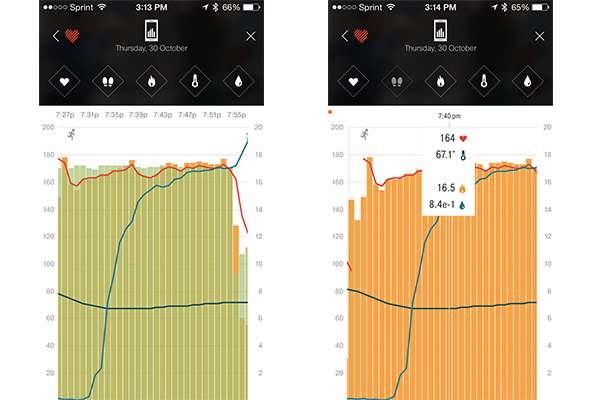
The Charting section is where Basis' app really separates itself from the competition. This page shows all the data collected by the Peak: heart rate, steps, calories, skin temperature and perspiration. It also plots them on a timeline. You can view as many or as few metrics as you want, and by pressing and holding on the screen, you can see your stats for any given point during the day. Somewhat frustratingly, the app shows only the current day, but I was testing a beta version of the app, and you can still see previous days and weeks via Basis' Web interface.

Activity Feed provides a summary of your activity for each day, showing your overall steps, resting heart rate and calories burned. Beneath each day, the feed shows what activities you were engaged in — Walking, Active or Running — and displays your average heart rate and calories burned for each activity.
MORE: Best Smartwatches
If you tap on a given activity, you're shown detailed charts for it. For example, I could see that after about 10 minutes of running, my perspiration levels jumped, and didn't drop noticeably until about 20 minutes after my exercise was finished.
While it's great to have all this data, Basis could do a better job of explaining what it means, and what's considered good and bad. For example, a perspiration measurement is given as "5.5e-3 uS/cm." What does that mean? It was also nice to know that my average skin temperature was 80 degrees Fahrenheit, but should it be higher or lower?

Curiously, the one metric the Peak doesn't record is distance — in feet, miles or kilometers — which feels like a major omission. Also, unlike the Microsoft Band, the Peak lacks built-in GPS, which is admittedly somewhat of a rarity for fitness trackers at this price.
Performance
One of the best things about the Peak is that, once you put it on your wrist, you really don't have to do anything with the device. It's smart enough to know when you start different activities, be it walking, running or sleeping.
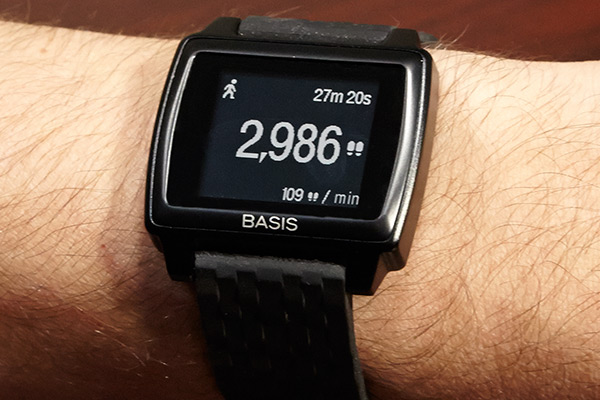
Although it's not as precise as a GPS-enabled device or a dedicated running watch, the Peak did a good job capturing all my activities. After I strapped on the band, I simply went about my day and night, wearing it as I would any other watch. I didn't have to remember to press a button when I was about to start exercising or falling asleep.
Heart Rate Monitor
Like the original B1 Band, the Peak has an optical heart rate sensor on its underside that continually tracks your beats per minute throughout the day.
I found the sensor to be fairly accurate. It was able to measure my heart rate whether I was sleeping, sitting, walking or running.
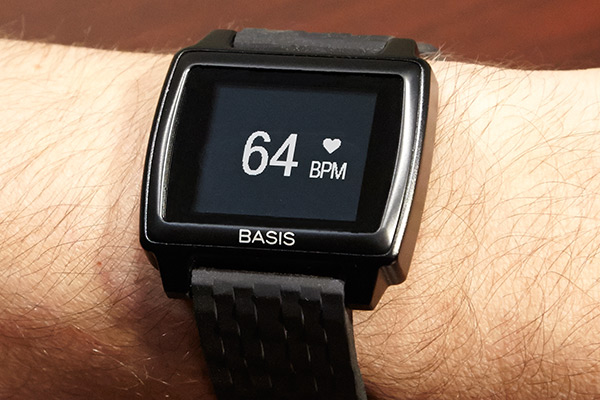
The heart rate monitors on some devices, such as the Samsung Gear Fit, only work if you're standing still.
Sleep Tracking
As with your activities during the day, the Peak also keeps meticulous records of your sleep patterns. Based on a combination of sensor data, including your movement and heart rate, the app breaks down your sleep into light, deep and REM sleep.
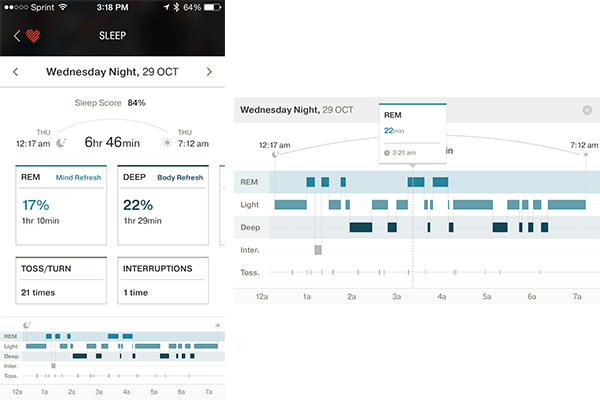
The app also notes how many times you tossed and turned, and how many times your sleep was interrupted. I like that the app tells you why REM and deep sleep is important, but I wish it told you how to get a better night's sleep.
I like the fact that the Peak automatically enters sleep mode, no pressing buttons like with the Vivosmart or the Microsoft Band. However, the Vivosmart has an alarm function to wake you up in the morning, which the Peak lacks.
Battery Life
Basis says the Peak should last up to four days on a charge. I started using the Peak on a Thursday, and had run it almost all the way down by Sunday night. That's on a par with the Garmin Vivosmart, and about two days longer than the Microsoft Band.
Bottom Line
Update 8/5/16) We initially praised the Basis Peak for its sleek hardware, smartphone notifications, and ability to track and convey a lot of information in an intuitive interface. However, in light of the Peak's overheating issues, and the fact that the company is recalling all of them, and shutting off service by the end of 2016, we do not recommend you buy it. For $50 less, the Garmin vivosmart HR ($149) delivers all the same data and features as the Peak, and will also show you the weather.
Follow Michael A. Prospero @mikeprospero and on Google+. Follow us @TomsGuide, on Facebook and on Google+.

Michael A. Prospero is the U.S. Editor-in-Chief for Tom’s Guide. He oversees all evergreen content and oversees the Homes, Smart Home, and Fitness/Wearables categories for the site. In his spare time, he also tests out the latest drones, electric scooters, and smart home gadgets, such as video doorbells. Before his tenure at Tom's Guide, he was the Reviews Editor for Laptop Magazine, a reporter at Fast Company, the Times of Trenton, and, many eons back, an intern at George magazine. He received his undergraduate degree from Boston College, where he worked on the campus newspaper The Heights, and then attended the Columbia University school of Journalism. When he’s not testing out the latest running watch, electric scooter, or skiing or training for a marathon, he’s probably using the latest sous vide machine, smoker, or pizza oven, to the delight — or chagrin — of his family.
